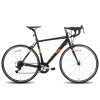Cycle Facts
Different types of cycle
Bicycles come in many different types, each designed for specific riding styles, terrains, and purposes. Here are some of the most common types of bicycles:
1. Road Bikes
- Description: Designed for speed and efficiency on paved roads.
- Features: Lightweight frame, narrow tires, drop handlebars, and a more aggressive riding position.
- Ideal For: Road cycling, racing, long-distance rides on smooth surfaces.
2. Mountain Bikes (MTB)
- Description: Built to handle rough, off-road trails and challenging terrains.
- Features: Wider, knobby tires for traction, a sturdy frame, suspension (front and/or rear), and flat handlebars for better control.
- Ideal For: Off-road trails, downhill riding, and rough terrain.
3. Hybrid Bikes
- Description: A mix of road and mountain bikes, designed for a variety of surfaces.
- Features: Medium-width tires, comfortable saddle, upright handlebars, and a more relaxed geometry.
- Ideal For: Commuting, fitness riding, light trails, and casual cycling on both paved and unpaved surfaces.
4. Cruiser Bikes
- Description: Designed for comfort and casual riding, often with retro styling.
- Features: Wide, cushioned tires, upright handlebars, wide saddles, and often equipped with fenders and baskets.
- Ideal For: Leisurely rides on smooth, flat terrain like beaches or urban areas.
5. Touring Bikes
- Description: Built for long-distance rides, often with the ability to carry heavy loads.
- Features: Strong, stable frame, multiple gear options, pannier racks, and a comfortable, upright riding position.
- Ideal For: Long-distance cycling, bikepacking, and touring with gear.
6. Gravel Bikes
- Description: A type of road bike designed for gravel paths and mixed-terrain riding.
- Features: Wider tires for more stability, drop handlebars, and a slightly more relaxed geometry compared to traditional road bikes.
- Ideal For: Gravel roads, adventure cycling, and bikepacking on rougher surfaces than paved roads.
7. Fat Bikes
- Description: Known for their very wide tires, fat bikes are designed for riding on sand, snow, and other soft, unstable terrains.
- Features: Extra-wide tires (usually 3.8 inches or wider), low tire pressure for maximum grip, and a sturdy frame.
- Ideal For: Snow, sand, and beach riding; off-road trails in difficult conditions.
8. Folding Bikes
- Description: Compact bikes that can be folded for easier storage and transport.
- Features: Folding frame, small wheels, and often lightweight.
- Ideal For: Commuting, travel, and situations where bike storage space is limited.
9. Fixie / Single-Speed Bikes
- Description: A bike with a single gear that lacks a freewheel mechanism, meaning the pedals move whenever the bike is moving.
- Features: Simple design, lightweight, low maintenance, and no gear shifting.
- Ideal For: Urban commuting, short distances, and riders who prefer simplicity and efficiency.
10. Electric Bikes (E-bikes)
- Description: Bicycles equipped with an electric motor that assists with pedaling.
- Features: Motor-assisted pedaling, batteries, throttle control, and often a more ergonomic design.
- Ideal For: Commuting, reducing effort on hilly terrain, or anyone looking for an extra boost.
11. Time Trial / Triathlon Bikes
- Description: Aerodynamically optimized bikes designed for competitive time trials and triathlons.
- Features: Aero handlebars, aero frame, and aero wheels designed to minimize drag and maximize speed.
- Ideal For: Time trials, triathlons, and racing on flat courses.
12. BMX Bikes
- Description: Small, strong bikes designed for racing and performing tricks.
- Features: 20-inch wheels, low frame, single gear, and often a sturdy design to withstand jumps and impacts.
- Ideal For: Freestyle riding, dirt jumping, and BMX racing.
13. Track Bikes
- Description: Bicycles designed specifically for racing on velodromes.
- Features: Fixed gear (no freewheel), aerodynamic frame, and very narrow tires.
- Ideal For: Velodrome racing, fixed-gear racing, and competitive track cycling.
14. Recumbent Bikes
- Description: A type of bike where the rider is seated in a laid-back position, with the pedals in front rather than below.
- Features: Comfortable, low seat, and a more aerodynamic riding position.
- Ideal For: Riders with back issues or those seeking comfort on long rides.
15. Single-Speed Bikes
- Description: A bike with only one gear and no derailleur system.
- Features: Simple design, lightweight, and easy maintenance.
- Ideal For: Flat terrain, city commuting, and those who prefer a minimalistic bike setup.
Each bike type serves a different purpose, so choosing the right one depends on your riding needs and the terrain you’ll be cycling on.






